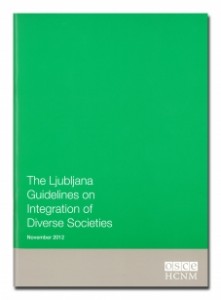Any of us who look to European institutions for perspectives on integration policies are most likely to head first to the European Union, whose revised strategy was published late last year or to the many contributions of the Council of Europe. But we could do well to pay attention to new guidance from a less expected source, the OSCE’s High Commissioner on National Minorities (a post held by Knut Vollebaek, a former Foreign Minister in Norway), launched in the Slovenian capital, Ljubljana, last week.
 The High Commissioner’s mandate is conflict prevention ‘at the earliest possible stage’ in relation to inter-ethnic tensions that could undermine peace or stability. His office has more often been associated with issues arising in Eastern Europe and central Asia than with those in their Western neighbours. But that is not the High Commissioner’s intention in this guidance, and there is much in the practical experience reflected within it that is relevant to tensions that can arise across the OSCE’s 56 participating states from the neighbourhood to the national level.
The High Commissioner’s mandate is conflict prevention ‘at the earliest possible stage’ in relation to inter-ethnic tensions that could undermine peace or stability. His office has more often been associated with issues arising in Eastern Europe and central Asia than with those in their Western neighbours. But that is not the High Commissioner’s intention in this guidance, and there is much in the practical experience reflected within it that is relevant to tensions that can arise across the OSCE’s 56 participating states from the neighbourhood to the national level.
About rights evolving identities
Refreshingly, the guidelines do not start from the premise that minorities are to blame or that it is principally they who must adapt. The High Commissioner’s experience is that ‘diversity alone is neither correlated nor causally linked with an increase in tensions and violence. None of the numerous ethnic conflicts that have erupted in post-Cold War Europe have been inevitable. They are a consequence of political choices that could have been different. Such conflicts are frequently rooted in the denial of basic rights and in the systematic and/or systematic exclusion and alienation of entire communities’ (p2).
With that analysis, the starting point is the protection of human rights. But experience on the ground has shown that recognising rights is not enough: States need to be proactive, dismantling barriers to effective participation and taking steps to foster an inclusive sense of belonging at the national and local level. In so doing, they need to recognise that identities are not fixed but evolving, multiple (not least by gender) and contextual. Maximalist positions – like rejecting the legitimacy of the state or its multi ethnic character are out, but there is no contradiction per se between having distinct identities and sharing a common sense of belonging. Bravo.
Tackling difficult issues head on
 At 65 pages this is a substantial document covering a broad range of policy from social and economic participation, language and education through to access to justice, law enforcement and Citizenship. Where such documents often shy away from touchy subjects, it takes some head on: like the need for politicians and public officials to avoid negative rhetoric that reinforces stereotypes, and a warning to the media to be aware of the consequences of reporting it.
At 65 pages this is a substantial document covering a broad range of policy from social and economic participation, language and education through to access to justice, law enforcement and Citizenship. Where such documents often shy away from touchy subjects, it takes some head on: like the need for politicians and public officials to avoid negative rhetoric that reinforces stereotypes, and a warning to the media to be aware of the consequences of reporting it.
These Ljubljana guidelines, reflecting the HCNM’s particular mandate, underplay some key issues – like the importance of integration into the labour market, tensions relating to religion, and the role that local authorities can and do play. No doubt many will find other points to question in such a controversial field. But there is much here that is constructive and on which the Western European participating states of the OSCE could usefully take note, as well as those further afield.